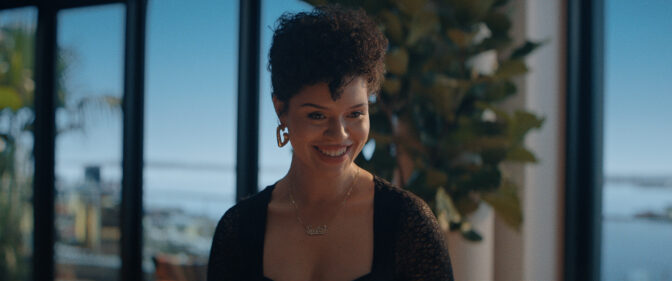After seeing Steven Spielberg’s “Minority Report,” my mind was churning with amazement and curiosity. Talking to Spielberg and his star, Tom Cruise, I found myself not an interviewer but simply a moviegoer, talking the way you do when you walk out of a movie that blindsides you with its brilliance.
Our conversation jumped from subject to subject. We talked about technique, special effects, compositions, imagining the future, playing fair with the tradition of film noir. I sort my notes into the topics that interest me the most.
The Department of Pre-Crime
Remarkable, that in the same week when the White House shuffled agencies into a new Department of Homeland Security, “Minority Report” is about a Department of Pre-Crime in the District of Columbia. Fifty years in the future, three “Pre-Cogs,” people with the ability to foresee the future, float in a tank with their brains wired to computer, predicting crimes before they happen.
Spielberg: “Today the only way to stop crimes is through intelligence and communication, but in our story the trio of Pre-Cogs is psychically gifted, and we’re able to use them to stop bad from happening. People are arrested and charged with being about to commit murder.”
Film noir and whodunits
Spielberg: “I had John Huston in my ear on ‘Minority Report.’ I went back and looked at ‘The Maltese Falcon’ and Hawks’ ‘The Big Sleep-‘ to see how some of those film noir mysteries were resolved. They didn’t dot every ‘i’ and cross every ‘t.’ They tried to keep you off-balance. They asked more questions than they could answer in those days.”
RE: “With your crime plot here, I think you play fair and answer all of the questions.”
Spielberg: “I went to Scott Frank for the screenplay. He wrote ‘Get Shorty’ and ‘Out of Sight.’ I gave him the original short story by Philip K. Dick and he said he didn’t know anything about science fiction. I said, ‘Let me worry about the sci fi element. Just write a terrific detective yarn. This taps into your strength. This is a murder mystery, a film noir, a whodunit.”
Cruise: “The idea of being able to predict a murder and stop it before it occurs–that’s stunning. And the idea of devising a perfect crime to get around the Pre-Cogs. That’s great for the short story, but for a feature film it needed personal elements. You have to care about the people. That’s what Scott Frank gave us.”
The future is now
For “2001: A Space Odyssey,” Stanley Kubrick famously consulted with industrial designers, futurists, advertising people, to try to visualize what the future world would look like. Spielberg does the same thing, imagining a world where ads recognize your retinal pattern, follow you around and speak to you.
Spielberg: “I wanted all the toys to come true someday. I want there to be a transportation system that doesn’t emit toxins into the atmosphere. And the newspaper that updates itself. At the same time, the city is not all skyscrapers with coils around them. In Washington, with its historical preservation rules, they’re never going to change some neighborhoods, or the Mall, the Jefferson Memorial and the Lincoln Memorial. We mixed the old and the new.”
The ads that talk to you
Spielberg: “The Internet is watching us now. If they want to. they can see what sites you visit. In the future, television will be watching us, and customizing itself to what it knows about us. The thrilling thing is, that will make us feel we’re part of the medium. The scary thing us, we’ll lose our right to privacy. An ad will appear in the air around us, talking directly to us.”
The brilliant two-shot
In the film, the Cruise character liberates the most talented of the Pre-Cogs, played by Samantha Morton, from the sensory deprivation tank, and drags her along with him in a desperate search for a killer who has outsmarted the Pre-Crime system, committed a perfect crime, and pinned it on Cruise.
Midway through this chase, there’s a closeup of the two of them, Morton hanging on Cruise’s shoulder, she looking left, he looking right, both of them exhausted and despairing. Spielberg holds the shot long enough for our eyes to look right, left, right, left, causing us to identify with their apprehension.
Spielberg: “I’m glad you noticed that shot. They are basically at that point the same person–two heads from one heart.”
RE: “Who would have thought there would be another way to compose a two-shot?”
Spielberg: “I swear to you I discovered that shot through the viewfinder. I had them hug and suddenly I saw it through the viewfinder and I asked Samantha to turn her head a little, for more profile, and I found this shot. I called Janusz Kaminski [the cinematographer] over and said, ‘Look at this thing! It’s amazing!’ And it was just there.”
Cruise: “It was Samantha’s first day on the film and she came on like lightning out of a bottle, and Steven found that profile shot. It’s one of my favorite shots in the movie. We were thinking we might use it on a poster at some point.”
The spiders
One of the tools of the movie’s futuristic crime fighters are tiny robotic “spiders” that scurry around, clickety-click, finding every warm-blooded person in a house, leaping onto their faces and performing a retinal scan to identify them. When the spiders go looking for Cruise, it’s a brilliant sequence using live action and the computer-generated spiders, which are absolutely convincing–unlike the somewhat awkwardly-integrated CGI sequences in certain other summer movies.
To outsmart the spiders, Cruise immerses himself in a bathtub filled with ice water, but a single bubble of air escapes from his nostril and a spider, about to leave the room, pauses with perfect timing, and goes back for another look.
Cruise: “That air bubble was not a computer effect. Steven said, ‘I need one bubble to come out of this nostril, and I thought, forget about CGI, I can get a bubble to come out. The things an actor does.”
Spielberg: “I’m directing computer spiders now. Look what my life has come to. I’ve used ILM [Industrial Light and Magic] my entire career but the spiders weren’t ILM. The whole spider sequence was by a company called PDI, the guys who worked on ‘Shrek’ for DreamWorks. There were only two animators and we spent many, many hours looking at variations. It was hard to get that little hesitation before the spider turns back again.”
The overhead shot
Spielberg: “Another shot I want to talk about is the overhead shot when the spiders first swarm into the tenement building. We’re looking straight down into all those rooms, and the camera follows the spiders over to a girl’s face, and to a guy sitting on the john–all these people in the building.
“Now that looks like it must be a computer shot but it isn’t. That’s a real, physical set. I tried to storyboard it, but it was so complicated, and finally Alex McDowell [the art director] suggested we try designing the shot on the computer. No set had been built yet. And we asked the computer, ‘How do we get this shot?’ and the computer said, ‘You need a crane that goes in and out.’ There happens to be a TechnoCrane than telescopes in and out like a car aerial, and the computer told us where to put the crane, how to move it, how to get all the shots I wanted, all in one take. Then Alex built the set. So, no, there’s not a single CHI shot in that sequence–but a computer told us how to do it!”
Real sets vs. computer-generated sets
Spielberg: “I really love George’s ‘Star Wars: Episode Two.’ I thought it was operatic–George’s most accomplished movie. But I don’t think I’ll ever go to computer-generated sets like he does. I think when you build a set in the 3-D world and actors walk onto that set, they get stimulated. They get ideas. Tom Cruise got ideas about how to play [his character] John Anderton because we built his house with four walls and a ceiling–every aspect was real. He felt at home there and got ideas about Anderton’s behavior. I’m sad for the day when sets will exist in cyberspace and not in real life.”
Real action vs. spidey action
RE: “I was surprised by how many e-mails I got after ‘Spider-Man’ and ‘Episode II’ from people who said, ‘Gee, I like it when they use models and miniatures and real sets and puppets.’ It may look real when done on a computer, but it looks real in a different way. There’s something missing.”
Spielberg: “Sometimes on ‘Spider-Man,’ which I quite liked, I enjoyed the CGI effects that made Spider-Man’s flying look like a comic book and not like reality. It put me back in all the Spider-Man comics I read growing up. [Director] Sam Raimi was trying to get that comic art look, and what it requires is that you make the live-action scenes with Toby Maguire look as much like comic art as the CGI swinging of Spider-Man. The trick is to get those values to meet in the middle.”
The computer operating system
In the film, Cruise operates a computer by manipulating virtual images in mid-air.
Cruise: “Steven called me over to his house and said ‘I’ve been thinking of this idea I call ‘scrubbing the image,’ and he showed it to me. He created this whole computer language so that he could physicalize it, free it from the keyboard. He gave the audience a visual way to discover it along with me. Of course when we shot those scenes there were no images, just my hands, and he came up with the music and would just talk me though it when we were shooting.”
The psychic chase
One virtuoso sequence shows Morton, as the Pre-Cog, helping Cruise elude pursuit by foreseeing what the pursuers will do and telling him how to evade them.
Cruise: “It’s amazing the speed at which the ideas just come to him. He thought of that Psychic Chase, and started adding details. Those little touches like when there’s a homeless man and she tells me to give him some money, and then she tells me to throw the coins on the floor, and then the man leans forward to pick them up and the cops trip over him.”
Working with Tom Cruise
Spielberg and Cruise have been friends for 20 years, and have been looking for a project together for 10 years.
Spielberg: “I like to consider Tom my William Holden. He’s going to be around until he’s an old, old man, if he wants to continue acting. He’ll be great-looking and he’ll be heartfelt as he is now; he’ll get better with age. He’s not afraid to cry, to lose his temper, to become unglued. I think of him as a character actor. Look at his character in ‘Magnolia’ and his Ron Kovic in ‘Born on the Fourth of July’ and Jerry Macguire, and the vampire Lestat. Those are characters.”











